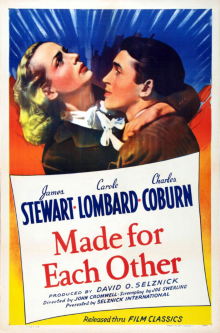
As you might expect, this one was included as the next entry in the list for the upcoming Marriage and the Movies course. The leads are Carole Lombard, who was a huge star in the late 1930s but this is I believe I’ve seen a movie of hers, and interestingly a much younger James Stewart, who was so impressive in Vertigo. In fact, I didn’t realize that it was the same actor but did have niggling feeling that I should know him from somewhere.
As with Wild Orchids, this film starts with the couple being already married except that this time they’re newlyweds. While on a business trip, young lawyer John Mason meets and falls in love with Jane and they immediately decide to marry. This upsets John’s mother who was expecting him to marry the daughter of his boss and sets the stage for a less than harmonious domestic scene. When a hoped for promotion at work doesn’t materialize and their financial situation deteriorates, even having a baby fails to bring happiness back into their lives.
If Wild Orchids is about the sanctity of marriage being challenged by the temptations of momentary passion, Made for Each Other is about how marriage is tested by the mundane realities of everyday life. This means arguments at home, sneering colleagues at work and headaches over bills. At times, it can feel like a surprisingly contemporary take on life. John doesn’t just feel anguish over not being able to support his family in the comfort that he feels they should be entitled to, he feels the burden of not living up to the success that everyone has expected out of him since high school.
Unfortunately it’s also a very warped portrayal. Jane is treated as a saint, being infinitely patient and supportive, but it doesn’t feel real because her character is so shallowly written. In fact, she has no family and apparently no last name of her own prior to her marriage. John is the only character to have any dramatic depth. But even in his case, it seems obvious that the writers wrote him into a corner by having problems pile up with no realistic solution in sight except by introducing a crisis such that at its end everything just magically works out alright. The final act of the movie is practically a farce. While I concede that it succeeds in creating tension, it’s an artificial obstacle whose resolution doesn’t rely on any of the protagonists.
I do get that the professor wanted a film that would show how dreams of the perfect marriage run aground when faced against the realities of everyday life but I find it hard to believe that this is the best way to do that. I see little to like about it and it’s no wonder that it’s been mostly forgotten.
2 thoughts on “Made For Each Other (1939)”